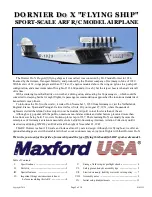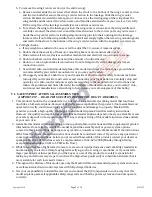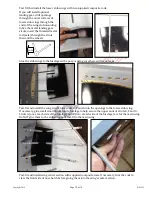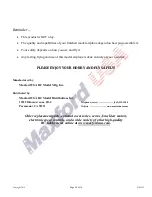
Copyright 2016
Page
1
of 14
S161222
D
D
O
O
R
R
N
N
I
I
E
E
R
R
D
D
O
O
X
X
"
"
F
F
L
L
Y
Y
I
I
N
N
G
G
S
S
H
H
I
I
P
P
"
"
S
S
P
P
O
O
R
R
T
T
-
-
S
S
C
C
A
A
L
L
E
E
A
A
R
R
F
F
R
R
/
/
C
C
M
M
O
O
D
D
E
E
L
L
A
A
I
I
R
R
P
P
L
L
A
A
N
N
E
E
The Dornier Do X
Flugschiff
(flying ship) as it was called, was conceived by Dr. Claude Dornier in 1924,
financed by the German Transport Ministry, and produced by the Dornier company of Germany in June of 1929.
With its crew of 14, wingspan greater than 157 feet, 12 engines mounted above the wing on pylons in a push-pull
configuration, and a maximum takeoff weight of 123,460 pounds, it was by far the largest heavier-than-air aircraft
of its time.
With a smoking room that had its own wet bar, a dining salon, and seating for 66 passengers – which could be
converted to sleeping berths for night flights, its passenger accommodations approached the luxurious standards of
transatlantic ocean liners.
To introduce the Do X to the world, it took off on November 3, 1930 from Germany to visit the Netherlands,
England, France, Spain and Portugal. It arrived at New York City on August 27, 1931, where thousands of
sightseers visited the Glenn Curtiss Airport (now LaGuardia Airport) to tour this leviathan of the air.
Although very popular with the public, numerous non-fatal accidents and other factors prevented more than
three from ever being built. Two were broken up for scrap in 1937. The remaining Do X eventually became the
centerpiece of Germany's aviation museum
Deutsche Luftfahrt-Sammlung
(German Aviation Collection) until it
was destroyed during WWII by an RAF air raid the night of November 23, 1943.
This RC Dornier is about 1/20 scale and took us almost 2 years to design. Although it is flying boat, we offer an
optional landing gear set with steerable tail wheel so our customers may enjoy more flights with their Dornier Do X.
We invite you to enjoy the pride of ownership and the joy of flying this beautiful ARF sport-scale model.
Table of Contents:
I.
Specifications
......................................................
2
V.
Storage, field setup & preflight checks
........................
4
II.
Parts list
................................................................
2
VI.
Safety precautions & assembly tips
..............................
5
III.
Special features
...................................................
3
VII.
Limited warranty, liability waiver & return policy
....
7
IV.
Important things customers must know
before assembling this ARF
...........................
4
VIII. Assembly notes
................................................................
8
IX.
Initial setup & adjustments
............................................
13
































